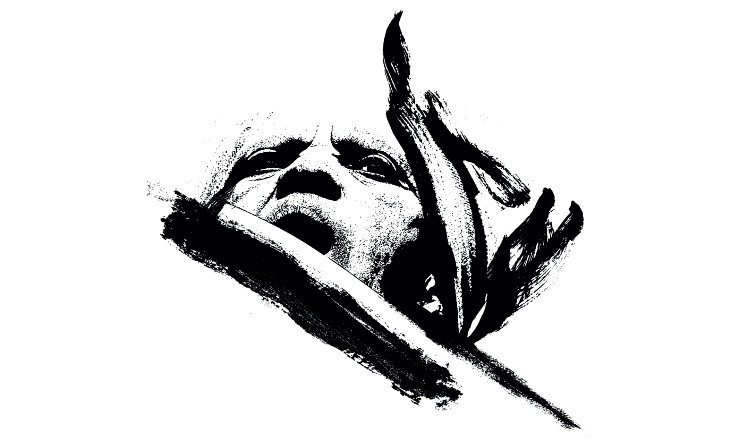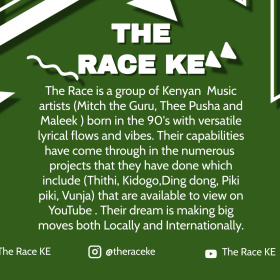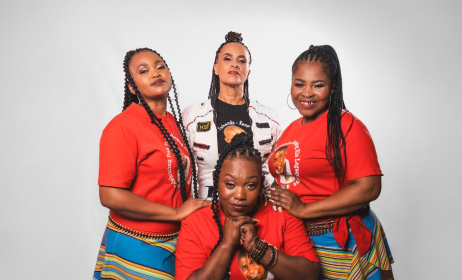Herri: A lens you can focus yourself
What do songs, lyrics and instruments from ancient indigenous cultures have in common with multimedia and the Internet? Perhaps the latter is the most apt medium to present and preserve the former. Curator Aryan Kaganof’s first edition of herri is a website redolent with images, songs, videos, writing, artworks and poems that provide an in-depth, colourful and absorbing exploration of traditional musician Matombi Matotiyana and the release of her first album, Songs of Greeting, Healing and Heritage.
 Mantombi Matotiyana playing the umrhubhe.
Mantombi Matotiyana playing the umrhubhe. Mantombi Matotiyana assisted in the studio by Ncebakazi Mnukwana. Photo: Aryan Kaganof
Mantombi Matotiyana assisted in the studio by Ncebakazi Mnukwana. Photo: Aryan Kaganof Tšepo Ntsukunyane's illustrations formed the backbone of the first herri issue.
Tšepo Ntsukunyane's illustrations formed the backbone of the first herri issue.
It’s the navigation of herri that makes it unique: it’s totally up to you. The site has a red dot to click on, and a couple of red arrows, but where you go from there depends entirely on what grabs your interest. You may find yourself reading a text; then choose to do so accompanied by a music clip; then elect to watch a video that has appeared as you scroll down. Your senses are tantalised while your intellect is stimulated.
“The design team has been tremendously important in working together to forge a visual identity that is distinctive and immersive. Kudos to Tšepo Ntsukunyane, whose illustrations have formed the backbone of the first issue, and Andrea Rolfes, who worked tirelessly to find a visual language appropriate to the project's ambitions,” Aryan says.
What/who is herri?
I like to immerse myself in whatever it is I write about before I sit before the computer, but realised after much immersion that herri is a truly enormous smorgasbord of information. Slightly overwhelmed, I asked Aryan what herri is, so he directed me to the ‘about’ section on the site, which reads: “herri is an attempt to answer the question, ‘what does decolonisation look like in this age of hybridity?’ We discovered that there is not just one answer. herri is a soundmine of narratives, mythologies, ideologies, statements, ambiguities and ideas just waiting to be excavated. herri is merely one option among many. Discontinuity is the continuity. Disconnection is the connection. Incoherence is the coherence.”
When I replied that this was a bit obscure for the average reader, and that I was trying to get an idea of where herri’s boundaries lie, he answered: “The focus will always be music first. That is to say, music that is geographically South African. But, for example, in the first issue there was a page on Moor Mother, and in the second issue there will be a feature on Jlin. So we basically also look at artists who are doing really challenging, interesting and formally ground-breaking experiments in music, irrespective of whether they are from South Africa or not.”
He also told me who the site is named after. “The name Herri is inspired by the first political prisoner to be jailed on Robben Island, Autshumao or Herri die strandloper [Herri the beach walker]. The spelling of 'Herri' as opposed to 'Herrie' is a decolonial orthography decision – we do not believe that the Dutch spelling of the sound ‘herri’ is necessary, and, inspired by the way SMS messages have influenced the orthography of contemporary Afrikaaps, we have decided to use herri as a flag signalling a de-linking from conventional colonial spelling. Herri the freedom fighter is inspiring, because he actually escaped from Robben Island.”
Patrick Mellet’s very thorough and extremely interesting new historical biography of Herri/Autshumao, which appears in the first issue of herri, details how the image of this man has been distorted by differing historical accounts, in typical colonial fashion. A huge amount of information about Herri was written down, but the Dutch could not accept his intelligence and entrepreneurship anymore than they could fathom the non-hierarchical systems that existed among the Khoi, and so he and his clan were cast in their minds and version of history as mere scavenger strandlopers.
African languages
“There’s one important thing about herri, something that for me was crucial in conceptualising what I wanted from the web-based medium,” says Aryan. “You will notice that many of the articles have a dual language button top-right. We designed the pages so that the articles that were available in more than one language would have these languages integrated, instead of a full-page article in English followed by a full-page article in isiXhosa or Sesotho; rather paragraph by paragraph flip-flopping.
“Writers could choose by clicking on the button of the language they preferred to write in, which would make the text of the chosen language larger and brighter on the page, in this way avoiding the pitfall of linguistic apartheid, and rather foregrounding the act of linguistic code switching itself, of chopping and changing between languages, which is much more like the actual practice of speaking in South Africa.
“Hopefully this will encourage people to explore the various languages available on the site, to actually look at paragraphs and sentences next to each other, opening up explorations of language as epistemic carriers, and also encouraging more writers to explore writing in their mother tongue [when it isn't English].”
Herri’s themes
Each issue of herri has a theme; herri 01, for instance, is based around the vocalist, uhadi, isitorotoro and umrhubhe player Mantombi Matotiyana, and specifically, the recording of her CD Songs of Greeting, Healing and Heritage, while Issue 2 is themed around the Afrikaans reggae band Country Conquerors.
“The theme invites writers to explore in detail the work of a South African music artist that we consider important. This kind of in-depth writing and analysis is sorely lacking in the contemporary media environment,” says Aryan. “Each issue of herri will invite writers to contribute to the various sections, gradually building into an intersectional archive of decolonial thinking, writing and doing.”
At the bottom of the site are sections with fabulous titles such as ‘borborygmus’, ‘claque’ and ‘ekaya’, which fulfil different functions, such as archiving and keeping a finger on the pulse of contemporary African music. Under claque is a brilliant description of the club scene in South Africa in the ‘90s, written by musician Warrick Sony, and based on a documentary by Zandi Tisane. It details the country’s optimistic transition from the ‘80s to the ‘90s, both musically and politically. Scrolling through these sections, one realises that herri embraces, and will embrace, many divergent expositions, beyond that of its main theme.
Analysing the album
The issues of copyright and publishing, how Songs of Greeting, Healing and Heritage was recorded, the technicalities and equipment, right down to what the artists ate between recordings – all appear in meticulous detail, written by various authors, in herri.
The themes of the album are those commonly experienced by black South Africans, such as how families were torn apart by the migrant worker system. Among others, Mantombi highlights the importance of healing, and just how painful it can be; and she recommends that indigenous people find and return to their origins or spiritual home.
Rithuli Orleyn finely dissects the words that Mantombi chose for her lyrics, including the culture and context behind those choices. She explores, for instance, the ambiguity of the isiXhosa word gona, used in the song ‘WenuseGoli’. Here Mantombi could be alluding to the fact that a woman left behind by her migrant worker husband may find that the relationship has grown cold, and that she may wish to fill her loneliness by taking a lover.
The issue of how to examine music itself, outside of the box imposed by Western conventions, is raised by Neo Muyanga: “We should start our conversation on the research of music that lives inside people, without following the example and stringent rules firmly created by colonists, or western ideology.”
Mbe Mbhele takes this further, reminding us that: “… this [South African] society has married so much of its coercer that it has lost itself. It can no longer recognise its own physiognomy. The song ‘Wachitheka Umzi Wendoda’ suggests, as a solution maybe, that we ought to stop this marriage to things and ways foreign. But then what follows: do we divorce that which we have already married?”
Mantombi the musician
Mantombi was born in the Eastern Cape in 1933. She moved to Cape Town in 1984 and started a small business in Nyanga township, selling meat, homemade beer and bead necklaces. Zungula ‘Dizu’ Plaatjies, leader of the ensemble Amampondo, noticed her musical talents and incorporated her into his ensemble. Mantombi brought to it the uhadi, the isitolotolo and her beautiful voice and aura. Now a full-time musician, she has played across the world and still works with Plaatjies.
Songs of Greeting, Healing and Heritage was recorded by David Langemann at Univeristy of Cape Town, in the the Chisholm Recital Hall of the university’s music department, in conjunction with the South African College of Music. Prof Michael Blake was the executive producer of the album, which was launched at the Theatre Arts Admin Collective in Observatory, Cape Town, in April 2019. It was the first album to be launched by the African Open Institute (AOI).
AOI is an autonomous, interdisciplinary institute in the Faculty of Arts and Social Sciences at Stellenbosch University. The institute encourages experimentation, openness and enquiry, but it also places emphasis on archiving, for which purpose it created the Documentation Centre for Music (DOMUS).
African Open Institute and decolonisation
When I asked Prof Stephanus Muller, head of DOMUS, what herri and the AOI are about, he said: “AOI works towards establishing an institutional space hospitable to experimentation and risk taking with respect to conventions on all levels of music practice and research in the university, and to develop an institutional home to all scholars and artists who are interested in cultivating new knowledge from the here and now.
“In all of our work we acknowledge the inevitability of the influence of South Africa’s past and actively work to reject colonialism and apartheid in their historical and contemporary manifestations. The curation of herri by Aryan is a clear example of how we see new work and exploration happening with the constant reminder of where we come from, and the crises that continue to rage around us. So in the curated content and the design of herri 01 you can see how we try to acknowledge that we function within the tension of continued and perpetuated socio-political injustices and economic inequalities, and the anticipation of engaging the potential of South Africa’s musical heritage and practices.
“herri also allows us to open up music research and the disciplines associated with institutional music teaching ‒ performance, composition, historiography, theory, analysis, musicology, ethnomusicology ‒ showing how the institute is open to all aspects of music and research … The institute is a laboratory for scholars and artists to pursue experimental work that seeks to give new meaning to what is conventionally understood as ‘research’ … herri is a kind of display window for how we see this happening in practice.”
Visit herri here.































Comments
Log in or register to post comments